tire type CHEVROLET TRACKER 1998 1.G Owners Manual
[x] Cancel search | Manufacturer: CHEVROLET, Model Year: 1998, Model line: TRACKER, Model: CHEVROLET TRACKER 1998 1.GPages: 386, PDF Size: 21.17 MB
Page 159 of 386
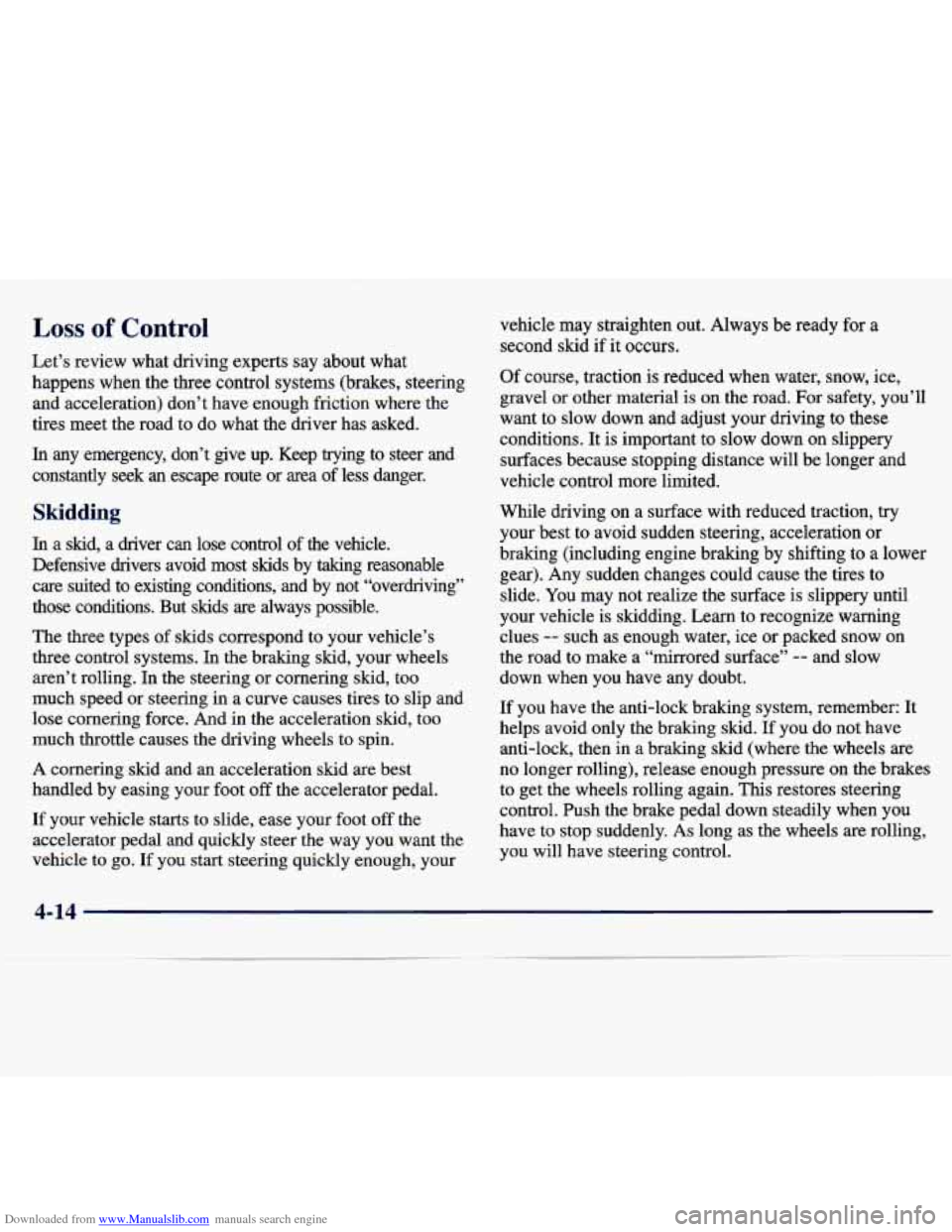
Downloaded from www.Manualslib.com manuals search engine Loss of Control
Let’s review what driving experts say about what
happens when the three control systems (brakes, steering and acceleration) don’t have enough friction where the
tires meet the road to do what the driver has asked.
In any emergency, don’t give up. Keep trying to steer and
constantly seek an escape route or area of less danger.
Skidding
In a skid, a driver can lose control of the vehicle.
Defensive drivers avoid most skids by taking reasonable
care suited to existing conditions, and by not “overdriving”\
those conditions. But skids are always possible.
The three types
of skids correspond to your vehicle’s
three control systems. In
the braking skid, your wheels
aren’t rolling. In the steering or cornering skid, too
much speed
or steering in a curve causes tires to slip and
lose cornering force. And in the acceleration skid, too
much throttle causes the driving wheels to spin.
A cornering skid and
an acceleration skid are best
handled by easing your foot
off the accelerator pedal.
If your vehicle starts to slide, ease your foot off the accelerator pedal
and quickly steer the way you want the
vehicle to
go. If you start steering quickly enough, your vehicle may straighten out. Always be ready
for a
second skid
if it occurs.
Of course, traction is reduced when water, snow, ice,
gravel
or other material is on the road. For safety, you’ll
want to slow down and adjust your driving to these
conditions. It
is important to slow down on slippery
surfaces because stopping distance will be longer and
vehicle control more limited.
While driving
on a surface with reduced traction, try
your best to avoid sudden steering, acceleration or
braking (including engine braking by shifting
to a lower
gear). Any sudden changes could cause the tires to
slide. You may not realize the surface is slippery until
your vehicle is skidding. Learn to recognize warning
clues
-- such as enough water, ice or packed snow on
the road to make a “mirrored surface”
-- and slow
down when you have any doubt.
If you have the anti-lock braking system, remember: It
helps avoid only the braking
skid. If you do not have
anti-lock, then in a braking skid (where the wheels are
no longer rolling), release enough pressure on the brakes to get
the wheels rolling again. This restores steering
control. Push the brake pedal down steadily when you
have
to stop suddenly. As long as the wheels are rolling,
you will have steering control.
Page 278 of 386

Downloaded from www.Manualslib.com manuals search engine Inflation -- Tire Pressure
The Tire-Loading Information label, which is on the
driver’s door lock pillar, shows the correct inflation
pressures for your tires when they’re cold. “Cold”
means your vehicle has been sitting for at least three
hours or driven no more than
1 mile ( 1.6 km).
NOTICE:
Don’t let anyone tell you that underinflation or
overinflation
is all right. It’s not. If your tires
don’t have enough
air (underinflation), you can
get the following:
Too much flexing
Too much heat
Tire overloading
Bad wear
Bad handling
0 Bad fuel economy.
NOTICE: (Continued) NOTICE: (Continued)
If your tires have too much air
(overinflation),
you can get the following:
Unusual wear
Bad handling
0 Rough ride
Needless damage from road hazards.
When to Check Check your tires once
a month or more. Also, check
the tire pressure
of the spare tire.
How to Check
Use
a good quality pocket-type gage to check tire
pressure.
You can’t tell if your tires are properly inflated
simply by looking at them. Radial tires may look
properly inflated even when they’re underinflated.
Be sure to put the valve caps back on the valve stems. They help prevent leaks by keeping out dirt
and moisture.
Page 281 of 386
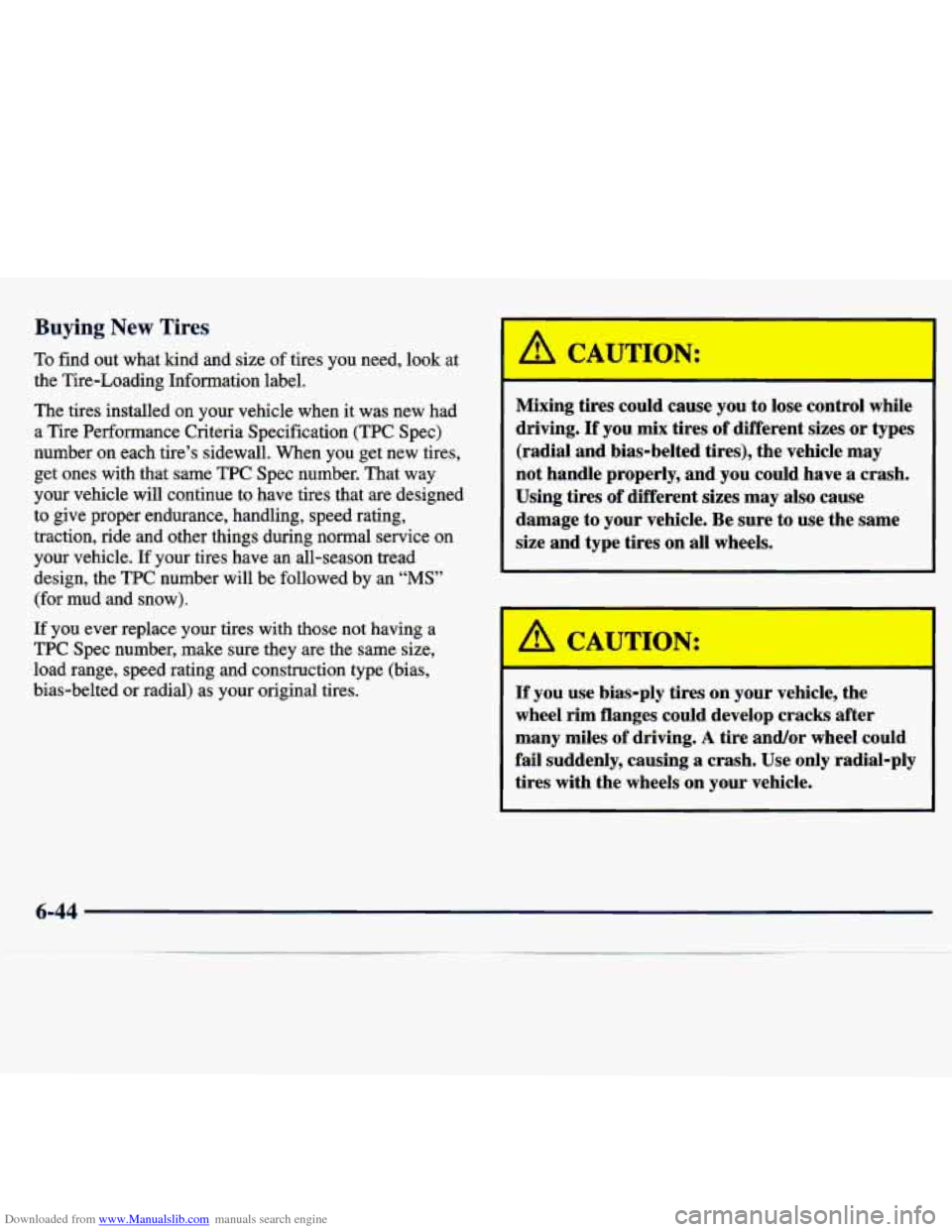
Downloaded from www.Manualslib.com manuals search engine Buying New Tires
To find out what kind and size of tires you need, look at
the Tire-Loading Information label.
The tires installed on your vehicle when it was new had
a Tire Performance Criteria Specification (TPC Spec)
number on each tire’s sidewall. When you get new tires, get ones with that same TPC Spec number. That way
your vehicle
will continue to have tires that are designed
to give proper endurance, handling, speed rating,
traction, ride and other things during normal service on
your vehicle. If your tires have an all-season tread
design, the
TPC number will be followed by an “MS”
(for mud and snow).
If you ever replace your tires with those not having a
TPC Spec number, make sure they are the same size,
load range, speed rating and construction type (bias,
bias-belted or radial) as your original tires.
& CAU’I DN:
Mixing tires could cause you to lose control while
driving. If you mix tires of different sizes or types
(radial and bias-belted tires), the vehicle may
not handle properly, and you could have a crash.
Using tires of different sizes may also cause
damage to your vehicle. Be sure
to use the same
size and type tires
on all wheels.
-
If you use bias-ply tires on your vehicle, the
wheel rim flanges could develop cracks after
many miles
of driving. A tire and/or wheel could
fail suddenly, causing
a crash. Use only radial-ply
tires with the wheels on your vehicle.
6-44
Page 282 of 386
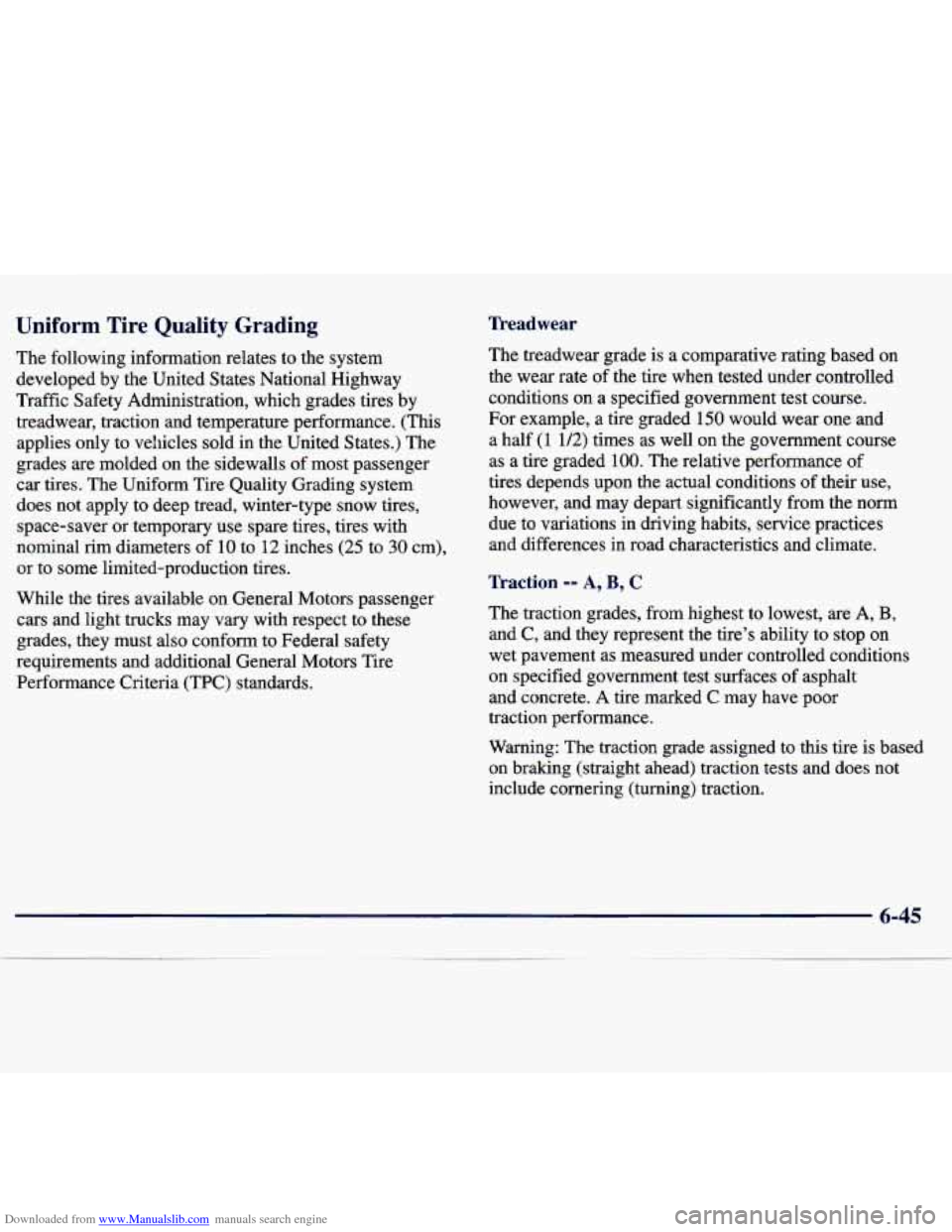
Downloaded from www.Manualslib.com manuals search engine Uniform Tire Quality Grading
The following information relates to the system
developed by the United States National Highway
Traffic Safety Administration, which grades tires by
treadwear, traction and temperature performance. (This applies only to vehicles sold in the United States.) The
grades are molded on the sidewalls of most passenger
car tires. The Uniform Tire Quality Grading system
does not apply to deep tread, winter-type snow tires,
space-saver or temporary use spare tires, tires with
nominal rim diameters of
10 to 12 inches (25 to 30 cm),
or to some limited-production tires.
While the tires available on General Motors passenger
cars and light trucks may vary with respect to these
grades, they must also conform to Federal safety
requirements and additional General Motors Tire
Performance Criteria
(PC) standards.
Treadwear
The treadwear grade is a comparative rating based on
the wear rate of the tire when tested under controlled
conditions on a specified government test course.
For example, a tire graded
150 would wear one and
a half (1 112) times as well on the government course
as a tire graded
100. The relative performance of
tires depends upon the actual conditions of their use,
however, and may depart significantly from the norm
due to variations in driving habits, service practices
and differences in road characteristics and climate.
Traction -- A, B, C
The traction grades, from highest to lowest, are A, B,
and C, and they represent the tire’s ability to stop on
wet pavement as measured under controlled conditions
on specified government test surfaces of asphalt
and concrete.
A tire marked C may have poor
traction performance.
Warning: The traction grade assigned to this tire is based
on braking (straight ahead) traction tests and does not
include cornering (turning) traction.
6-45
Page 284 of 386
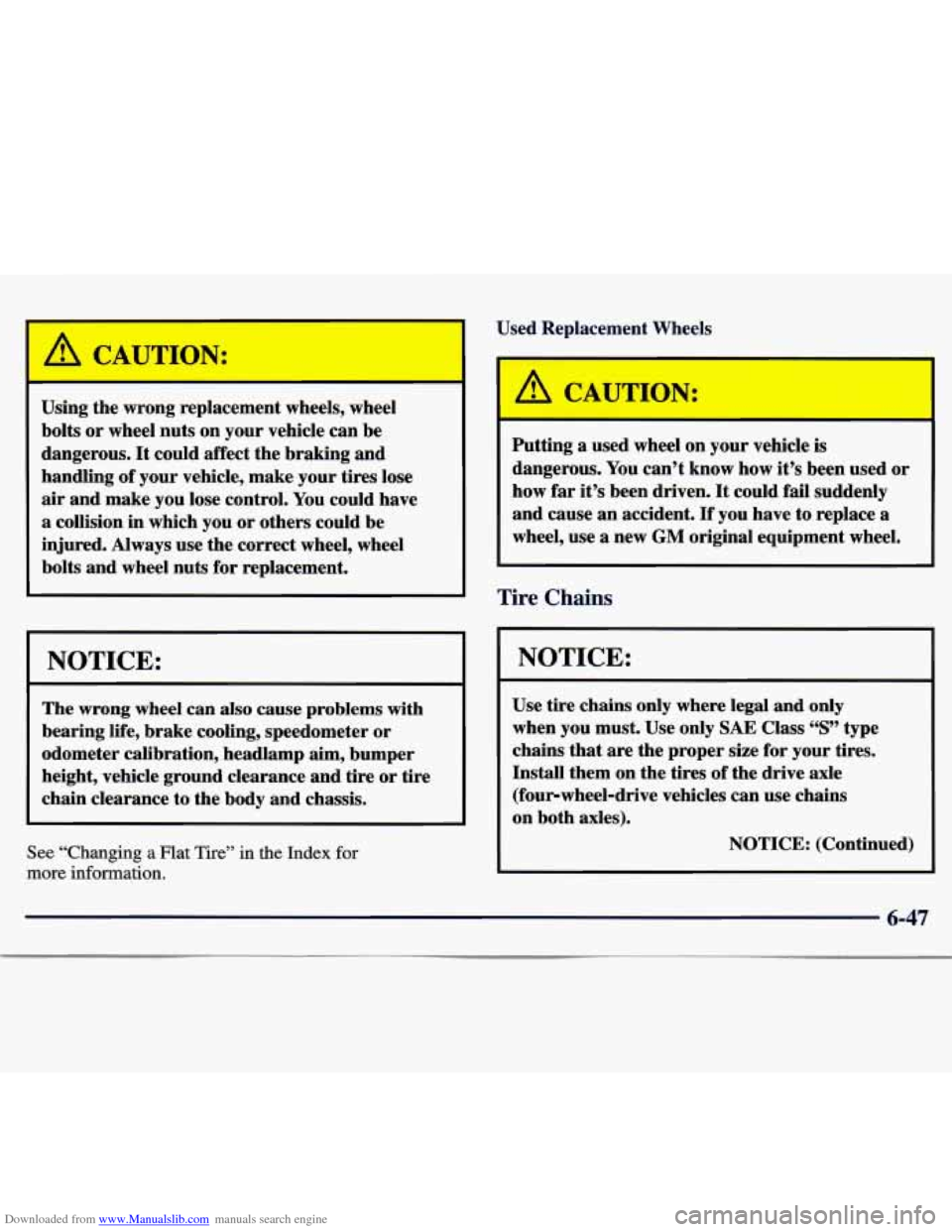
Downloaded from www.Manualslib.com manuals search engine ,A CAUTION:
Using the wrong replacement wheels, wheel
bolts or wheel nuts on your vehicle can be
dangerous. It could affect the braking and
handling of your vehicle, make your tires lose
air and make you lose control. You could have
a collision in which you or others could be
injured. Always use the correct wheel, wheel
bolts and wheel nuts for replacement.
NOTICE:
The wrong wheel can also cause problems with
bearing
life, brake cooling, speedometer or
odometer calibration, headlamp aim, bumper
height, vehicle ground clearance and
tire or tire
chain clearance to the body and chassis.
See “Changing a Flat Tire” in the Index for
more information.
Used Replacement Wheels
L A CAUTION:
Putting a used wheel on your vehicle is
dangerous. You can’t know how it’s been used
or
how far it’s been driven. It could fail suddenly
and cause an accident.
If you have to replace a
wheel, use a new GM original equipment wheel.
Tire Chains
NOTICE:
Use tire chains only where legal and only
when you must. Use only SAE Class “S” type
chains that are the proper size for your tires.
Install them on the tires of the drive axle
(four-wheel-drive vehicles can use chains
on both axles).
NOTICE: (Continued)
6-47
Page 293 of 386
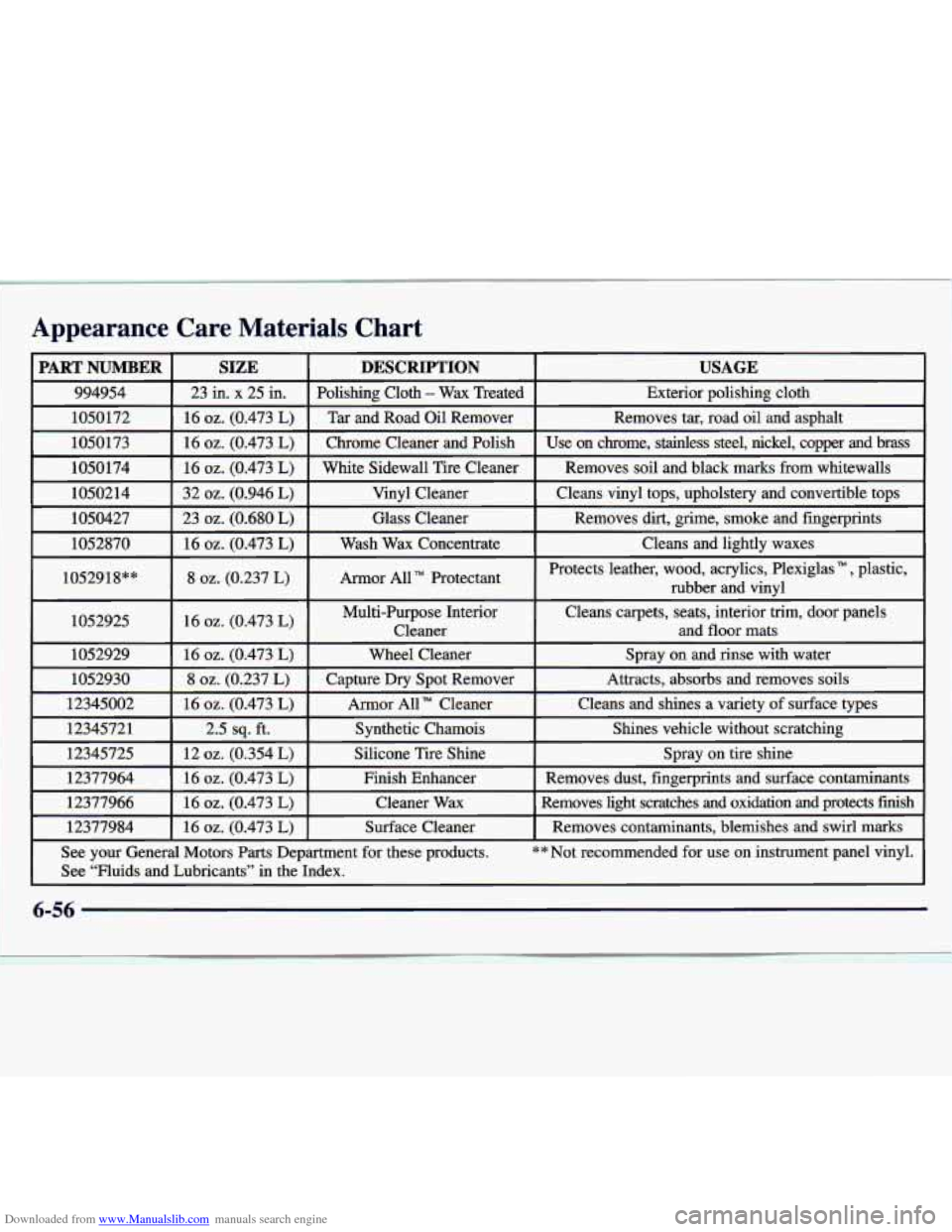
Downloaded from www.Manualslib.com manuals search engine Appearance Care Materials Chart
PART NUMBER SIZE
DESCRIPTION USAGE
~~
994954 23 in. x 25 in. Polishing Cloth - Wax Treated Exterior polishing cloth
~~
1050172 16 oz. (0.473 L) Tar and Road Oil Remover Removes tar, road oil an\
d asDhalt
1050173 16
oz. (0.473 L) Chrome Cleaner and Polish Use on chrome, stainless steel, nickel, copper and bras7
1050174
16 oz. (0.473 L) White Sidewall Tire Cleaner Removes soil and black marks from whitewalls
1050214 32
oz. (0.946 L) Vinyl Cleaner Cleans vinyl tops, upholstery and convertible tops
1050427 23
oz. (0.680 L) Glass Cleaner Removes dirt, grime, smoke and fingerprints
1052870 16
oz. (0.473 L) Wash Wax Concentrate Cleans and lightly waxes
I 1052918"" I 8 oz. (0.237 L) I Armor
All" Protectant I
Protects leather, wood, acrylics, Plexiglas " , plastic,
rubber and vinvl
I
1052925 16 oz. (0.473 L)
1052929 16 oz. (0.473 L) Wheel Cleaner Spray on and rinse with water
Multi-Purpose Interior Cleans carpets, seats, interior trim, door\
panels
Cleaner and floor mats I I I
I 1052930 I 8 oz. (0.237 L) I Capture Dry Spot Remover I Attracts, absorbs and removes soils I
--
I
I I A ..L I
12345002 I 16 oz. (0.473 L) I Armor All TM Cleaner I Cleans and shines a variety of surface types I I I
I 1234572 1 I 2.5 sq. ft. I Synthetic Chamois I Shines vehicle without scratching;
--
I I I
I 12345725 I 12 oz. (0.354 L) I Silicone Tire Shine I Spray on tire shine I
v
I I I
I 12377964 I 16 oz. (0.473 L) I Finish Enhancer I Removes dust, fingerprints and surface contaminants I
--
12377966 16 oz. (0.473 L) Cleaner Wax Removes light scratches and oxidation and protects finish
12377984 16
oz. (0.473 L) Surface Cleaner Removes contaminants, blemishes and swirl marks
See your General Motors
Parts Department for these products. ** Not recommended for use on instrument panel vinyl.
See
"Fluids and Lubricants" in the Index. __ -_ _ - c
6-56